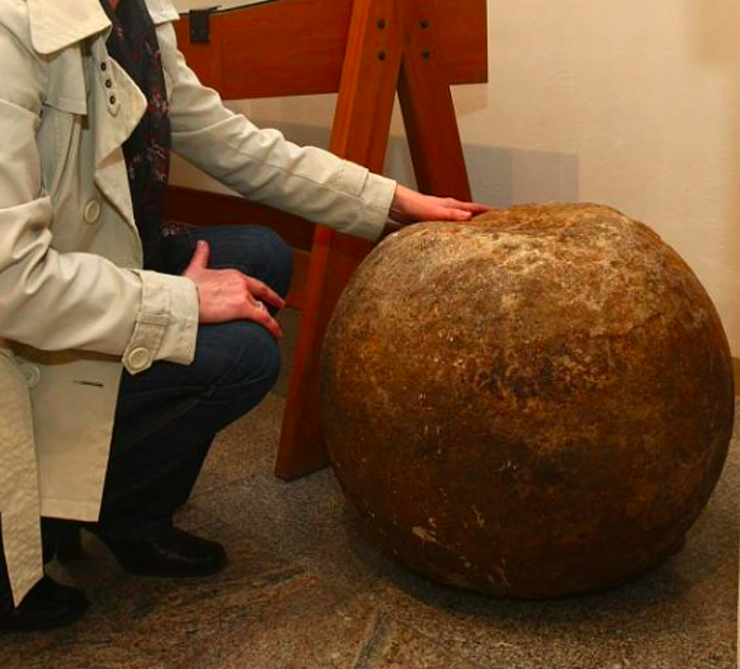Neskutečné... jen si představit, co to muselo dát kameníkům práce jí udělat. Díky za článek. 
April 3, 2009 Hussite cannonball
Categories: Years of war and revolution , Finds and rescue research in the Czech Republic , Calendar
Archaeologists found a half-meter cannonball in the historic center of Pilsen twelve years ago. It dates from the fifteenth century and probably belonged to the Hussites. In the past, the city was intensively blasted.
The sphere was examined by experts from the West Bohemian Museum. "It's a stone missile, from the oldest type of cannon, which was called a bomb. The sphere was fired during the siege of Pilsen by the Hussites in the years 1433 to 1434, "said Jiří Orna on behalf of the museum.
Archaeologists pulled out a sphere while examining the so-called Mill Ditch in Pilsen, which is considered to be one of the most beautiful places in the city. At present, it is an artificial lake and park landscaping in the orchard circuit on the eastern side of the historic center of Pilsen between Pražská Street and Štruncovy sady. The water area is reminiscent of the original Mlýnská ditch, which flowed through these places until the 1920s.
The finding of a stone ball is not so surprising. The Hussites actually bombed the city very intensively, and according to Orna, they even tried to hit the Church of St. Bartholomew at Sunday Mass. The Hussite troops led by Prokop Holý besieged Catholic Pilsen for nine months and twenty-three days, and the city eventually withstood this long siege.
Orna also has an explanation of how the ball probably got into Mlýnská strouha, which in the past was called the delta arm of the Radbuza river, which disconnected in places in front of today's West Bohemian Museum in Pilsen above the Royal Weir.
"The ball probably got into the ditch after 1921, when it no longer served its purposes and the city had it taken away. The find has already been placed in the Pilsen City Armory. A sphere fifty centimeters in diameter lay in the backfill and was made of local sandstone. When the ditch became binding after the cancellation in the mentioned year, they used such waste for that, "said the expert.
It was so far the oldest object he found in Mlýnská strouze. Until then, it was mainly things from the beginning of the twentieth century. The sphere is now part of the exposition of the town armory in the West Bohemian Museum. Work on Mlýnská strouze, for which the city paid 65 million crowns, was also completed.

Sources: https://pam.plzne.cz/, www.denik.cz, MF DNES
The article is included in categories:
- Archive of articles > Years of war and revolution
- Archive of articles > Archaeology > Finds and rescue research in the Czech Republic
- Archive of articles > Calendar
Post
Tak to je parádní koule, tu bych chtěl mít na zahradě  Dobrý článek!
Dobrý článek!
Přátelé kdo píšete články, buďte realisté. ... Dovedete si představit tohle vypálit z děla?
Váha, tvar, materiál...
U nás když husité oblehaly Karlštejn tak používaly přesně takovéhle projektily do obřích praků kterýmy ostrelovaly hrad z protějších kopců..., v hradních sbírkách jich je několik zachovalých a další se našli pod hradem a na kopci Plešivec kde byl jeden prak umístěn.... Čili si myslím že je střela do praku, ale školy nemám... mohu se mýlit.
J.Deeer - archeolog a šéf západočeské muzea Jiří Orna snad ví, co mluví. No ni?
https://plzensky.denik.cz/zpravy_region/v-plzni-se-nasla-husitska-delova-koule20090409.html
https://youtu.be/MIpFt81RgCg?t=38
Namor jak píšu mohu se mýlit..... Ale stejně tak se může mýlit i ten pán 
https://m.youtube.com/watch?v=cs8gamnMIS0
Ano, jeden z vás se mýlí. Ale mýliti se, je lidské 
Ten strejda bude asi konstruktér, dobře to spočítal 
Průměr půl metru... Historicky tak velký bombardy existovaly, ale zřejmě v takových číslech bylo jenom pár těch nejslavnějších na světě. Takže teoreticky jo, ale moc se mi nezdá, že by husiti měli takovou zbraň.
https://en.wikipedia.org/wiki/Bombard_(weapon)
https://en.wikipedia.org/wiki/List_of_the_largest_cannon_by_caliber
Na trebuchetu se mi zase nezdá, jak až moc je to kulatý. Trebuchet vystřelí cokoliv. Ty kameny do něj se sice zakulacovaly (asi se to na aerodynamice pozná), ale pochybuju, že tak pečlivě.
JohnDeere - taky jsem si myslel, že není možný, aby se s tímhle střílelo z děla. Ale v tomhle článku to potvrzují. https://www.flamberg.cz/lanky/34--struny-vyvoj-dlostelby-v-evrop-do-16-stoleti.html A dokonce uvádí ráži některých bombard až na 80cm!!! Dokonce potvrzují i materiál - kámen. Nešikovné, ale levné.
No já jsem za koulí do děla. Tyhle koule se necpaly dovnitř do laufu celé. Byly na kraji a byly zaklinovany dřevěnými klíny. Do trabuchetu už je tahle koule, myslím si, moc fajnova.
Do obléhání Plzně 1433/34 se zapojilo 40 bombard-hrubých kusů. Těch 50cm nebyla u nás nijak vyjimečná ráže,což bezpečně dokládají i deponované nálezy.
Prakový projektily neprocházely navíc takhle dokonalým zpracováním,byly pouze nahrubo otesaný.
Třeba lapidárium zmíněnýho Karlštejna-nahoře prakový projektily,dole koule z hrubých kusů.Jasně je vidět rozdíl v jejich opracování.
https://www.idnes.cz/revue/spolecnost/na-karlstejne-strasi-tvrdi-kastelan.A010226_161415_senzace_jup
Tak to vypadá vážně na tu dělovou, to jsem se s prakem asi zmýlil..... Každopádně bych u té bombardy nechtěl stát když se odpalovalo, náhodou by tam tu kouli zadělali víc než je zdrávo a to by potom byla šupička 















